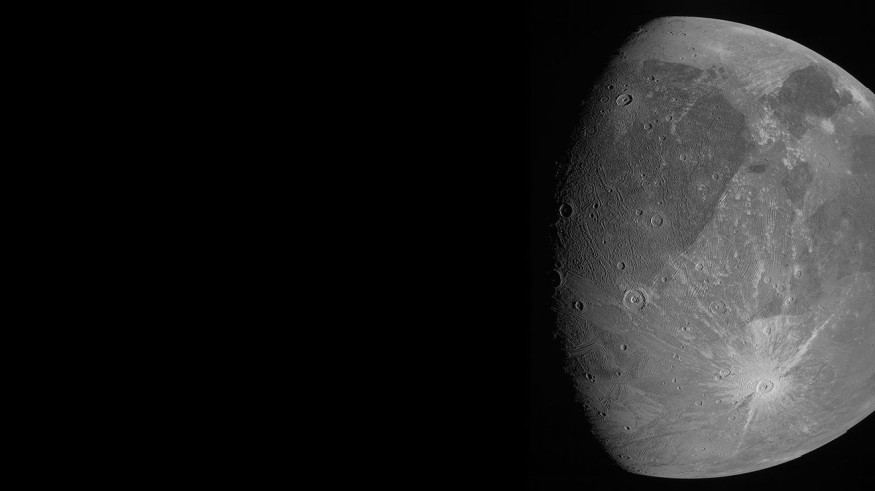NASA's Juno spacecraft has sent some close-up photos of Ganymede, one of Jupiter's four Galilean moons and the Solar System's largest natural satellite.
The images were taken from a distance of around 1,000 kilometers. Thus, the given image covers around 0.6 kilometers of the moon per pixel.
According to NASA, the breathtaking view shows swaths of frozen plains, pockmarks of enormous craters, and long surface streaks.

It's the first time in more than 20 years that a spacecraft has come this close to Ganymede.
"This is the closest any spacecraft has come to this mammoth moon in a generation," Juno Principal Investigator Scott Bolton of the Southwest Research Institute in San Antonio said in a statement released by NASA. "We are going to take our time before we draw any scientific conclusions, but until then we can simply marvel at this celestial wonder."
Science Times reported that the Juno spacecraft flew within 645 miles (1,038 kilometers) of Jupiter's massive satellite Ganymede, which is larger than Mercury.
Juno's was a one-time pass; its primary mission is to explore Jupiter. However, the European Space Agency is planning to launch a dedicated mission to Jupiter's moons soon.
The JUpiter ICy moons Explorer - or Juice for short - will sail by two additional Galilean moons, Callisto and Europa, before settling into a stable orbit around Ganymede in 2032.
Juno Reveals Ganymede's Shattered, Damaged Surface
The first image above reveals Ganymede's "damaged and shattered" surface in incredible detail. It showed virtually the whole side of the crater-pocked Ganymede, which is supposed to be home to a vast ocean of liquid water beneath its ice cover.
The image was taken with JunoCam's green filter; photos taken with the camera's red and blue filters will be released later, resulting in a color portrait of Ganymede, Gizmodo said.
However, since Ganymede's ocean is likely sandwiched between two ice layers, it isn't as astrobiologically interesting as the buried oceans of Jupiter's Europa and Saturn's Enceladus which are in contact with rocky interiors, Space.com reported, allowing for a variety of complex chemical reactions.
Stellar Reference Unit, a black-and-white camera used by Juno for navigation, provided the second image. The side of Ganymede opposite the Sun, which is dimly lighted by light reflecting from Jupiter, is shown in this photograph.

Astronomers will compare the photos taken by NASA's Galileo (1995-2003) and Voyager (1979) missions to discover if any changes have occurred over time.
"The conditions in which we collected the dark side image of Ganymede were ideal for a low-light camera like our Stellar Reference Unit," Heidi Becker, Juno's radiation-monitoring lead at NASA's Jet Propulsion Laboratory in Southern California, said in a statement.
"So this is a different part of the surface than seen by JunoCam in direct sunlight," Becker said. "It will be fun to see what the two teams can piece together."
One of the things that fascinate astronomers about Ganymede, Callisto, and Europa is that they all seem to contain oceans of water beneath their ice covers. However, NASA said Ganymede the only moon known to have a magnetic field, indicating what scientists believe to be a salty ocean underneath its surface.
Juno began its journey to Jupiter in August 2011 and arrived in July 2016. The solar-powered probe is gathering data on Jupiter's composition, inner structure, and magnetic and gravitational fields, which will aid scientists in better understanding how Jupiter and our solar system arose and evolved.
Juno occasionally shifts its acute gaze to other bodies in the Jovian system, such as Ganymede, which is 3,273 miles (5,268 kilometers) across. According to NASA scientists, observations taken during Monday's flyby could yield important details on the moon's composition, ice shell, and radiation environment, among other things.
RELATED ARTICLE : Why Did NASA Skip Their Missions to Jupiter, Neptune Moons?
Check out more news and information on Space on Science Times.
© 2026 ScienceTimes.com All rights reserved. Do not reproduce without permission. The window to the world of Science Times.











